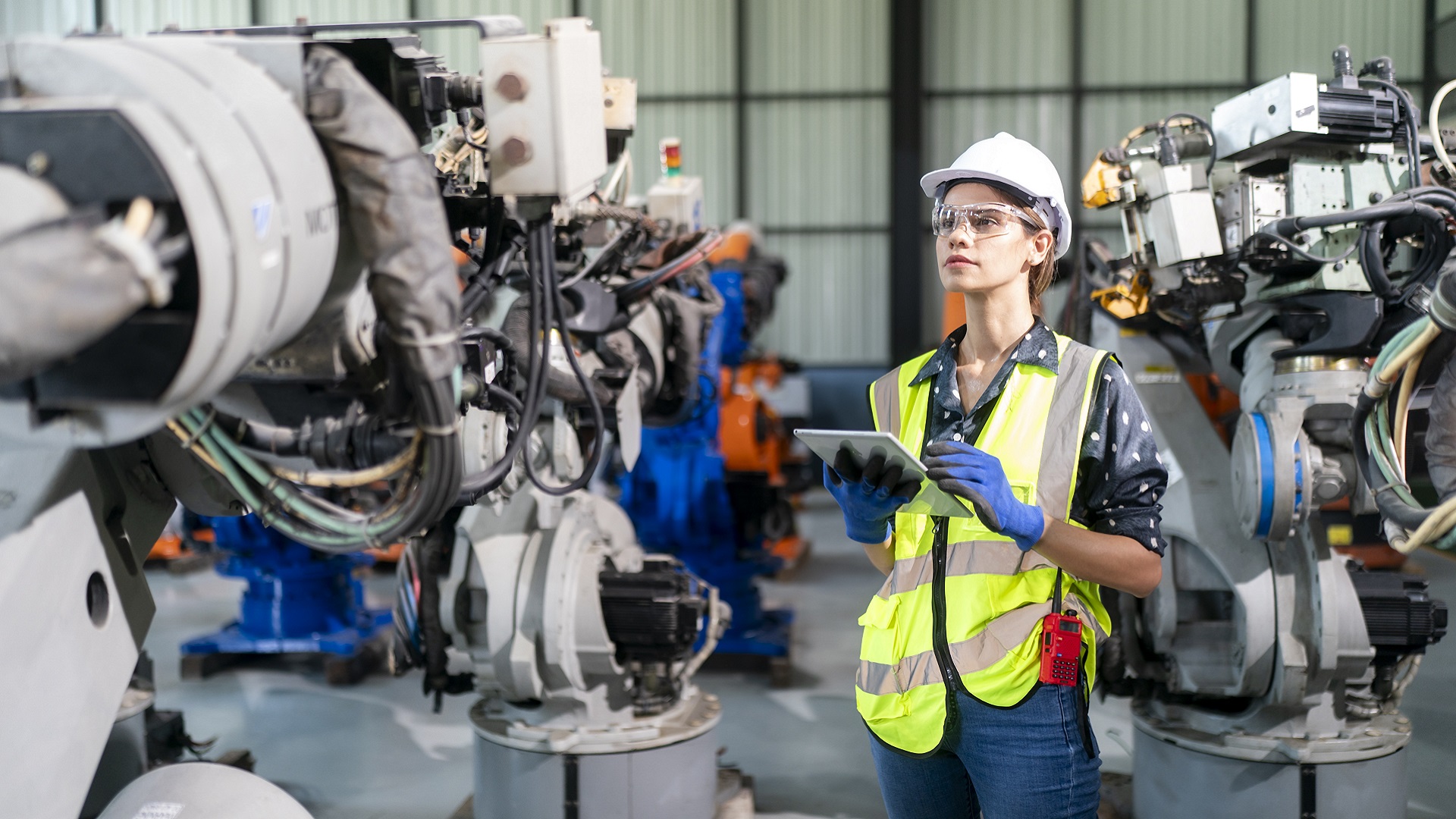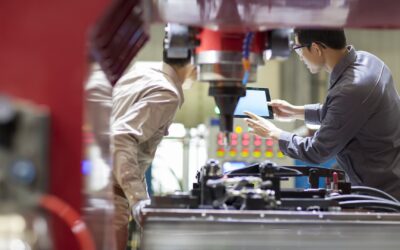ANN ARBOR – Neil Balduc, the owner of Tritegrity Machine, a small Tier 2 CNC manufacturer in Michigan’s Upper Peninsula, was ecstatic when he got word from the Michigan Economic Development Corp. that he was awarded a matching grant of $25,000 from the Industry 4.0 fund. The money allowed him to buy a co-bot for his seven-person shop.
“The co-bot does machine tending,” Balduc said. “Load and unload a CNC machine. It is our first step in automation and increases machine up-time and run-time without an operator. It makes us more productive.”
Without the $25,000 matching grant (he had to spend $50,000 to get $25,000 from the MEDC) he would not have been able to afford the co-bot on his own, he said. It’s also possible with the improved efficiency, Tritegrity Machine may be able to soon hire a few new workers, he added. Increasing employment in Michigan is MEDC’s prime directive.
“It’s a great example of what we’re seeing around the state with manufacturers,” said A. Elizabeth Bernhard, executive director of the Manufacturing Growth Alliance (MGA) that represents some 6,000 of the state’s estimated 12,000 manufacturers in all industries. Her members include transportation, plastics, food processing, beverage industry, and medical devices, as well as in Tritegrity Machine’s case, the paper industry. Balduc’s company makes paper converters that transform giant paper rolls into a host of paper products.
In a nearly a year-long series of interviews with managers at auto Original Equipment Manufacturers, Tier 1 auto system makers, Tier 2 and 3 parts makers and auto experts the consensus is the OEMs can better afford to fund I4.0 technologies than the much smaller parts makers. Even if they can afford some of the high-tech products and services under the I4.0 umbrella, many don’t know what technologies will provide the highest efficiencies and best return on investment.
Supporting Manufacturers in the State of Michigan
Enter the Michigan Economic Development Corp and its efforts to solve both problems for manufacturers. The MEDC has provided two $3 million I4.0 grants, one in June 2022 and a second in January 2023. Bernhard said the first tranche, what MEDC hoped would provide funding for two years, was used up by December 2022. The second $3 million grant program still has some money available, but funds will be exhausted soon.
“If Michigan really wants to be the world epicenter for advanced manufacturing, the state of Michigan needs to provide a lot more financial support,” Bernhard said. “At MGA alone we’d need another $155 million to provide $25,000 grants to all those manufacturers that said they needed the money to buy Industry 4.0 equipment.”
The state treasury has a $6 billion surplus right now. Just $1 billion from that surplus would jump start I4.0 manufacturing statewide.
Under an ambitious goal announced in December 2022, the MEDC seeks to get at least half the state’s estimated 12,000 manufacturers using some I4.0 technologies by January 2026. Scott Phillips, the manufacturing expert in residence at the I4.0 accelerator at Lawrence Technological University, estimated that roughly one-third or 4,000 manufacturers have achieved that milestone so far, leaving some 2,000 manufacturers short of MEDC’s goal.
The Fourth Industrial Revolution, dubbed I4.0, goes far beyond the robots introduced to the factory floor in the last century to include automation, data interchange, and contemporary manufacturing technology. I4.0 includes computing, Artificial Intelligence (AI), 3D Printing, and the incorporation of advanced sensors for predictive machinery maintenance. If Michigan continues to wear the crown as the world’s leading manufacturing region it’s 100-year-old plus manufacturing sector needs to embrace these technologies to compete with the rapidly retooling rest of the world.
New vs. Existing Employee Challenges in I4.0
As Industry 4.0 takes shape, there’s a seismic shift in how employees are trained, and problems are addressed in the manufacturing sector. New entrants, while tech-savvy, must navigate the complex interplay between cutting-edge digital tools and time-tested manufacturing practices. Comprehensive training is key, ensuring that newcomers not only grasp the latest tech but also understand the age-old subtleties of manufacturing.
Conversely, seasoned professionals, with decades of hands-on experience, often find themselves wrestling with new I4.0 technologies. The challenge lies in blending their vast knowledge with these emerging tools. Rapid, effective solutions that merge traditional practices with the latest tech are vital to keeping Michigan’s manufacturing at the forefront.
Modern training tools, such as learning management systems (LMS), online courses, and video tutorials, are gaining traction. However, at the heart of Industry 4.0 is the need for operational excellence. Manufacturers must focus on real-time problem-solving and practical on-the-ground solutions.
This approach requires a robust system for capturing, managing, and sharing knowledge. The ultimate goal? A smooth-running manufacturing line that minimizes costs and upholds the highest standards of production. Or as one OEM executive said what his company needs is the ability to capture innovation as it happens.
One solution under development is a smart phone video capture software backed by Artificial Intelligence that uploads video “aha moments,” then indexes them to a cloud-based database that can be vetted and shared quickly companywide – visualize it as a “video suggestion box.”
MEDC Grants for Manufacturing
MEDC Senior Vice President Natalie Chmiko, who leads the I4.0 program for the MEDC, readily admits the cost of technology remains a barrier for Industry 4.0 participation, particularly for small to medium-sized manufacturers.
“This is something we need to continue to focus on supporting manufacturing through economic development,” she said. “We continue to advocate for additional funding and hope to grow it in future. The first round was gobbled up quickly. We hope to scale in the future and continue to advocate on that.”
The other big issue is that manufacturing as we know it is changing rapidly. Without embracing technology and disrupting the traditional methods for way things are made, suppliers very survival may be at stake.
To solve that problem the MEDC enlisted educational institutions and regional partners that deal directly with Michigan manufacturers. That group includes Automation Alley, the Industry 4.0 Accelerator hosted by Lawrence Technological University and Lean Rocket Lab, Networks Northwest, Great Lakes Bay Manufacturers Association, the Right Place, Macomb County, MGA and Southwest Michigan First. Chmiko said she hopes to work with more educational partners in the future to help support this initiative.
Another big problem for many smaller manufacturers is they don’t have the engineering or research and development departments that their multi-billion-dollar OEM and Tier 1 partners can afford to tell them exactly what technology they need to increase productivity.
To solve this problem, the MEDC has partnered with the Michigan Manufacturing Technology Center to help manufacturers determine what technologies will help them streamline operations, cut costs, and provide a solid return on investment.
Advanced manufacturing equipment and software have big price tags, often far more than the smaller companies can afford on their own. Case in point Neil Balduc, the owner of Tritegrity Machine, who wouldn’t have been able to buy his co-bot without the state grant.
“Profit margins are narrow,” the MGA’s Bernard said. “So, the majority of manufacturers have not purchased I4.0 technology. CEOs are overwhelmed trying to stay ahead of so many demands, including demands on their time. Even a simple grant application is challenging for them to complete.”
She said 166 manufacturers started filling out the first grant application but did not finish it.. Bernard noted she had to push Tritegrity Machine’s Balduc to complete his.
“Half of Michigan manufactures we’ve spoken with have shown interest in investing in I4.0,” Bernard said. “MEDC has done a good job of securing the initial $6 million investment, but we need to continue to fund this initiative. We need another $155 million investment to fund our small manufacturers.”
With Michigan government and the auto industry pushing hard to make the state the epicenter of Electric Vehicle manufacturing, the Michigan legislature needs to come up with more I4.0 development money, Bernhard said. Michigan has a $9 billion surplus. Some of that money could be used to expand the I4.0 grant program.
“The EV industry would be a tremendous investment in I4.0,” Bernard said. “It’s vital Michigan keeps the needs of second- and third-tier manufactures front and center and the critical part they plan in the EV supply chain. Getting more investment in the auto-supply chain is a critical problem that MGA is leading.”
Chmiko said the aim of the MEDC’s matching grants program is exactly that, to help Tier 2s and 3s experiment with I4.0 technologies.
“Manufacturers can buy a sensor and throw it on a machine at low cost,” Chmiko said. “They can buy a 3D printer to print prototypes. We’re trying to make it easier for them to navigate and also make sure there is a learning curve for investing in I4.0.”
Chmiko said manufacturers also need to create an innovative culture that allows them to make inexpensive mistakes rather then throw a lot of money at something that does not move the needle. She added I4.0 can help eliminate capacity constraints and labor issues, among the many reasons how I4.0 can help manufacturers.
When they try I4.0 that find out it helps them become more efficient. Case in point, the initial $6 million investment paid big dividends, Chmiko said. MEDC awarded 185 grants through its six regional partners, that in turn increased revenue by $230 million, created 780 new jobs and retained 3,600 more. The grant money also leveraged $24.6 million in private investment by Michigan small manufacturers, she noted.
Read the article in full here.
Sign up today for a free Essential Membership to Automation Alley to keep your finger on the pulse of digital transformation in Michigan and beyond.
Founder of Michigan News Network, and serves as CEO, as well as Editor & Publisher of MITECHNEWS.COM. Brennan has worked since 1980 as a technology writer at newspapers in New York, NY, San Jose, CA., Seattle, WA., Memphis, TN., Detroit, MI., and London, England. He co-founded and served as managing editor of Pacific Rim News Service (SEATTLE), which developed a network of more than 100 freelance journalists in 17 Asia-Pacific countries.




